#temnospondyl
Text


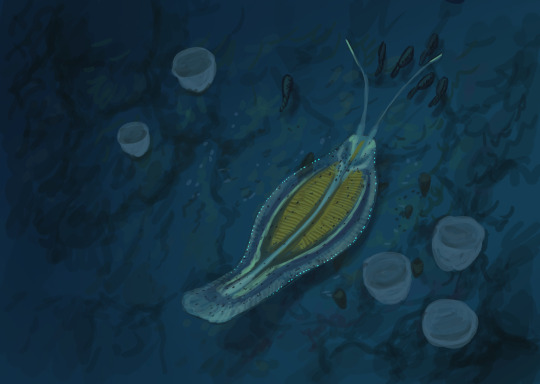
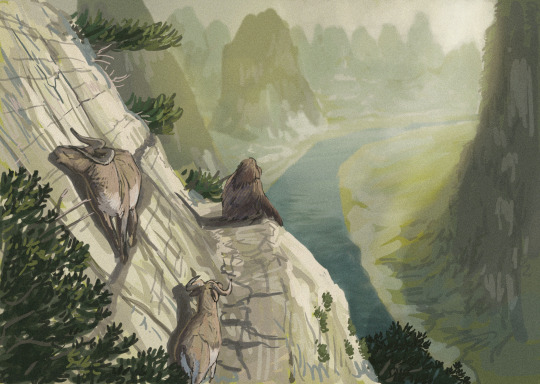
Results from the #paleostream
Entelognathus, Stenokranio, Timorebestia and Megalovis (with one big ape as well).
#sciart#paleoart#paleostream#palaeoblr#fish#placoderm#amphibian#stenokranio#pleistocene#goat#sketch#temnospondyl#arrow worm#gigantopithecus
1K notes
·
View notes
Text
Ok so, here’s a funky fact: in the early evolution of fish, the claspers (reproductive organs still present in modern sharks) actually began as a genuine third pair of limbs. Sooo what if instead of becoming purely reproductive, the claspers instead developed into full on legs.
Basically what I’m saying here is six-finned fish -> hexapedal early tetrapods -> hexapedal temnospondyls -> hexapodal tiny weirdo arboreal dendrerpetids that develop membranes to glide -> amphibian dragons
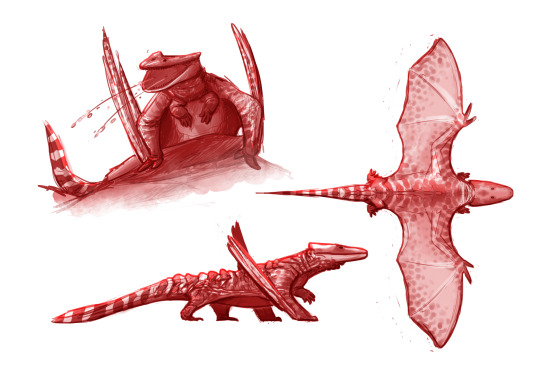
they have little grabby hands and spurt venom out of their mouths and they are my precious new babies
#dragons#speculative evolution#temnospondyl#paleontology#technically#I am not tagging this as palaeoart though#although in this hypothetical universe it would be#these guys would be roughly permian in age I think
16K notes
·
View notes
Text
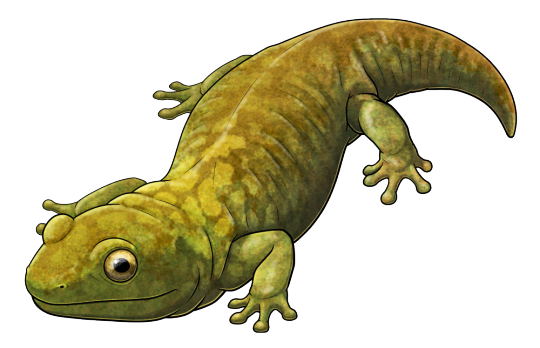
Despite being named after the famous Muppet frog, Kermitops gratus here wasn't actually a frog itself. Instead it was a close relative of the common ancestor of all modern amphibians, part of a grouping of amphibian-like animals known as amphibamiform temnospondyls.
Living in what is now Texas, USA, during the mid-Permian, about 275 million years ago, Kermitops would have resembled a chunky salamander. Only its fossil skull is known, so its full body size is uncertain, but based on the proportions of related amphibamiformes it was probably around 15-20cm long (~6-8").
Although its discovery helps to fill in the very sparse fossil record of the early evolution of modern amphibians, it's also complicated matters more than expected. Previously it was thought that the characteristic skull anatomy of modern amphibians evolved in a clear sequence, but Kermitops has a unique mix of features that doesn't fit this idea – suggesting that there was a lot of convergent evolution going on in amphibamiformes at the time.
———
NixIllustration.com | Tumblr | Patreon
#science illustration#paleontology#paleoart#palaeoblr#kermitops#amphibamiformes#dissorophoidea#temnospondyl#amphibian#stem-lissamphibian#tetrapod#art#it's not easy bein' green#somebody name an entelodont after miss piggy next please
362 notes
·
View notes
Text
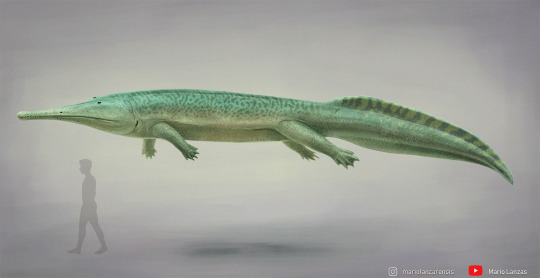

PRIONOSUCHUS
PRIONOSUCHUS is one of the animals featured in my VIDEO dedicated to the Permian period. It was one of the largest Amphibians ever to exist. Lived in what is now Brazil.
__
Youtube channel
Instagram
Prints and more paleomerch
64 notes
·
View notes
Text
Paleostream 11/3/2023

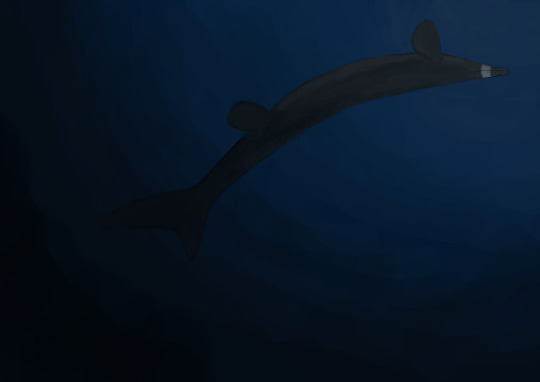

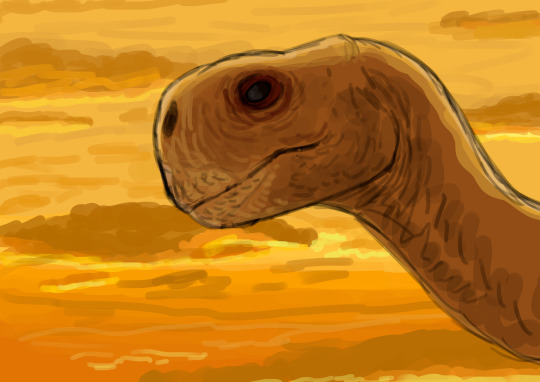
Yet another goofy and massively unserious set of roughly twenty minute sketches from today's flocking #paleostream featuring a cool Koolasuchus, a rotated Jormungandr, a questionable Prionosuchus, and a wise Hesperotestudo.
#art#paleostream#paleoart#paleontology#paleoblr#prehistoric#digital illustration#mosasaurid#temnospondyl
93 notes
·
View notes
Text

Some guys from the Flocking tonight, with varying degrees of accuracy and stylization.
#paleo#paleoart#paleomedia#paleontology#paleostream#Koolasuchus#Prionosuchus#jormungandr#Hesperotestudo bermudae#temnospondyl#turtle#tortoise#mosasaur#mesozoic#Cenozoic#paleozoic
92 notes
·
View notes
Text


Eryops, an amphibian from the Carboniferous and Permian.
225 notes
·
View notes
Text

How much is the fish!? - New 'spondyl drop:
"A new eryopid temnospondyl from the Carboniferous–Permian boundary of Germany"
https://www.cambridge.org/core/journals/journal-of-paleontology/article/abs/new-eryopid-temnospondyl-from-the-carboniferouspermian-boundary-of-germany/992657993894BEF3C1F7E964C87709DF
Back in december I had the chance to visit the Geoskop Museum and catch a quick glimpse at Stenokranio boldi and other specimen yet to be described.
Real geek talk here: there is nothing more exciting than discoveries in the making.
So here is a little rerendering of an Eryops I drew back in 2021.
53 notes
·
View notes
Photo
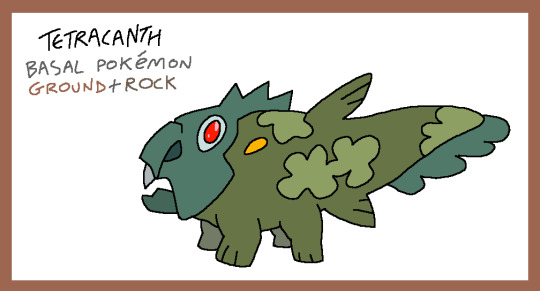
A convergent pokemon with relicanth - this fella’s a sort of stem-tetrapod.
#fakemon#pokemon#convergent evolution#ground type#rock type#stem tetrapod#tetrapod#ichthyostega#amphibian#lobe finned fish#temnospondyl#relicanth
401 notes
·
View notes
Text
Xenobrachyops, a triassic temnospondyl amphibian
Xenorhinos, a cenozoic old world leaf-nosed bat
Xenorhynchopsis, a cenozoic flamingo, the largest known from the fossil record.

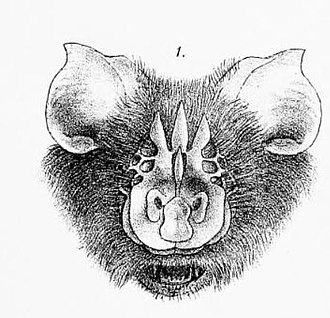

#palaeoblr#australian fossil alphabet thing#megafauna#temnospondyl#flamingo#xenobrachyops#xenorhinos#xenorhynchopsis
36 notes
·
View notes
Text
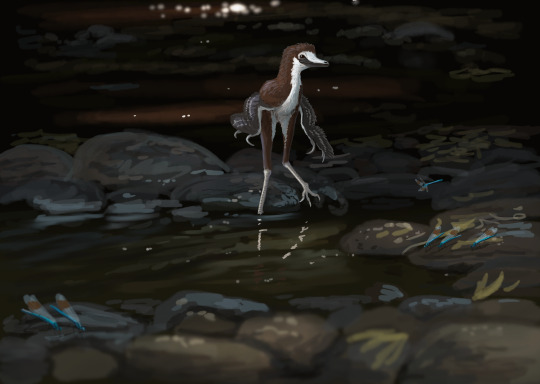


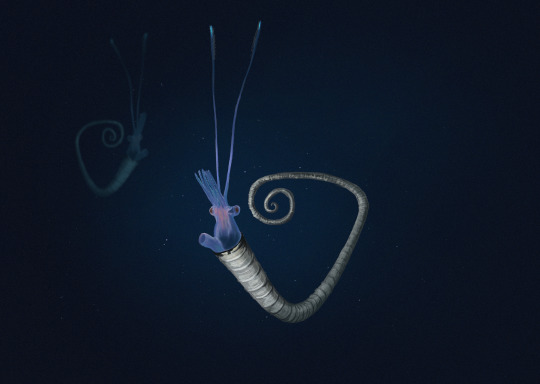
Results from the #paleostream!
Fujianvenator, Uruyiella, Sinopa, Scalarites
1K notes
·
View notes
Text

Loose thoughts on nonexistent paleozoic poetry
#brain burp#jan brzechwa#famous founder of my blog name#eurypterid#temnospondyl#dunkleosteus#doing the henri matisse dance 24/7 in my head#Przemyslenia na temat Projektu#paleozoic
48 notes
·
View notes
Text
Crystal Palace Field Trip Part 1: Walking With Victorian Monsters

The Crystal Palace Dinosaurs take their name from the original Crystal Palace, a glass-paned exhibition building originally constructed for a World's Fair in Hyde Park in 1851.
In 1854 the structure was relocated 14km (~9 miles) south to the newly-created Crystal Palace Park, and a collection of over 30 life-sized statues of prehistoric animals were commissioned to accompany the reopening – creating a sort of Victorian dinosaur theme park – sculpted by Benjamin Waterhouse Hawkins with consultation from paleontologist Sir Richard Owen.
The Palace building itself burned down completely in 1936, and today only the ruins of its terraces remain in the northeast of the park grounds.

The Crystal Palace building then and now
Left image circa 1854 (public domain)
Right image circa 2011 by Mark Ahsmann (CC BY-SA 3.0)
Six sphinx statues based on the Great Sphinx of Tanis also survive up among the Palace ruins, flanking some of the terrace staircases. They fell into serious disrepair during the latter half of the 20th century, but in 2017 they all finally got some much-needed preservation work, repairing them and restoring their original Victorian red paint jobs.

———
…But let's get to what we're really here for. Dinosaurs! (…And assorted other prehistoric beasties!)
The "Dinosaur Court" down in the south end of the park still remains to this day, displayed across several islands in a man-made lake. Over the decades they've been through multiple cycles of neglect and renovation, and are currently cared for by the London Borough of Bromley (Crystal Palace Park Trust are due to take over custodial duties in September 2023), with promotion and fundraising assistance from organizations like Historic England and the Friends of the Crystal Palace Dinosaurs charity.
Just about 170 years old now, the Crystal Palace Dinosaurs represent fifteen different types of fossil creatures known to 1850s Victorian science, with only three actual dinosaur species featured. Although often derided for being outdated and very inaccurate by modern standards, they were actually incredibly good efforts at the time, especially taking into account that the field of paleontology was still in its very early days.
They also just have a lot of charm, with toothy grins and surprisingly dynamic poses.
Unfortunately on the day I visited in early August 2023 most of the statues were heavily obscured by plant growth, both on their islands and on the sides of the paths they can usually be viewed from. Since I'd seen images from about a month ago showing things being less overgrown, this was probably just some unlucky timing on my part coinciding with some explosive summer foliage growth.
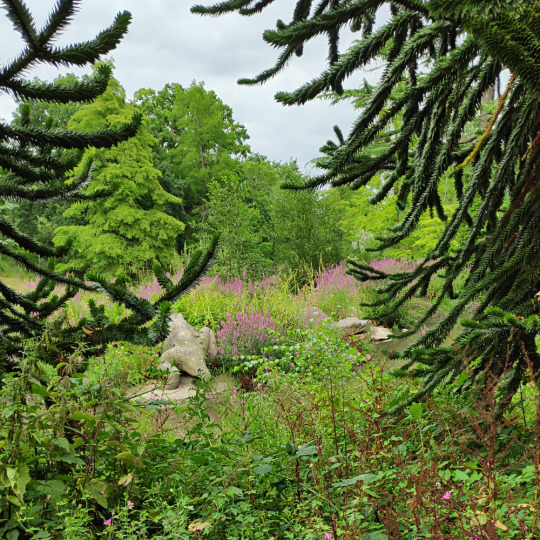
The first island on the trail features a few Permian and Triassic animals which were only known from fragmentary remains in the 1850s. These "labyrinthodonts" were recognized as having similarities to both amphibians and reptiles, and so were depicted with boxy toothy jaws, warty skin, stumpy tails, and long frog-like back legs.

Today we'd call these particular animals temnospondyl amphibians, specifically Mastodonsaurus, and we know they were actually shaped more like giant salamanders with longer flatter crocodilian-like jaws, smaller legs, and long paddle-like tails.

———

Somewhere in the foliage beyond this specific "labyrinthodont" there was also supposed to be a pair of dicynodonts, but I couldn't see much of them at all and didn't manage to get a remotely visible photograph.

Crystal Palace Dicynodon when much less overgrown
Left photo by London looks (CC BY 2.0)
Right photo by Loz Pycock (CC BY SA 2.0)
These Dicynodon are depicted as looking like sabre-toothed turtles complete with shells. That was fairly speculative even for the time, but considering only their weird turtle-beaked-and-walrus-tusked skulls were known it was probably the best guess Hawkins and Owen had. Today we know these animals were actually synapsids related to modern mammals, but Victorian understanding considered them to be a type of reptile.
Modern reconstructions of dicynodonts have a slightly different face shape, along with squat pig-like bodies and semi-sprawling limbs. They may have had fur, but currently the only known actual skin impressions from the genus Lystrosaurus show leathery bumpy hairless skin.

———
Next time: the Jurassic and Cretaceous sculptures!
#field trip!#crystal palace dinosaurs#retrosaurs#i love them your honor#crystal palace park#crystal palace#labyrinthodont#temnospondyl#mastodonsaurus#dicynodont#dicynodon#synapsid#paleontology#vintage paleoart#art
374 notes
·
View notes
Text
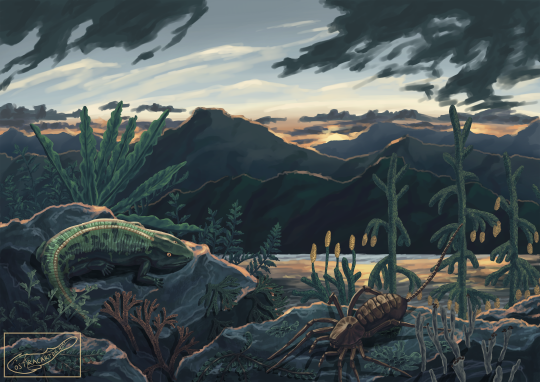
Permian sunset with Peltobatrachus and an early arachnid
#paleoart#peltobatrachus#amphibian#diapsid#tetrapod#arachnid#palaeoart#landscape#landscape art#plants#lycophytes#temnospondyl
327 notes
·
View notes
Text

Ischigualasto series, alternate takes:
Pelorocephalus, color pencil, 2023
#paleoart#triassic#illustration#ischigualasto formation#pelorocephalus#chigutisauridae#temnospondyli#temnospondyl#amphibian#color pencil
22 notes
·
View notes
Text

Crassigyrinus Slap
55 notes
·
View notes